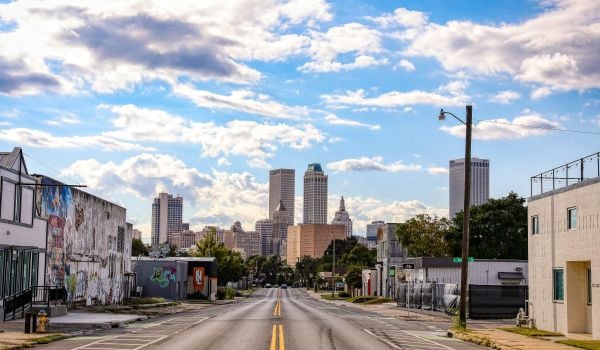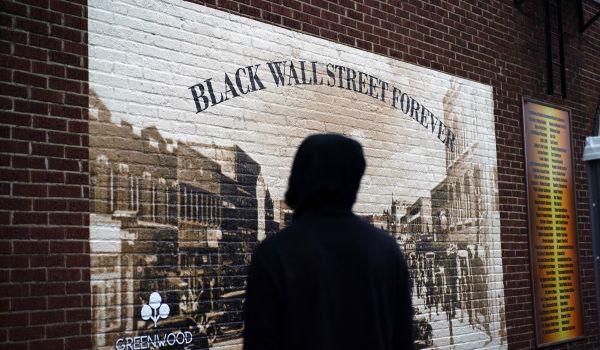In the two years before she moved back to Oklahoma, Jen Holk spent time living in Boston, Chicago, and Washington, D.C. A consultant who works with social-impact organizations, Holk, who grew up in a small town outside Tulsa, had become a committed city dweller. She’d also become accustomed to working remotely and traveling regularly. But she always thought about moving closer to her family. So when she heard that a program called Tulsa Remote was paying remote workers $10,000 to move to Tulsa, she figured it was time.
“A place like Tulsa is big enough to have all the amenities that I wanted from a big city — it just doesn’t have any duplicates,” Holk says. “If you want your ‘80s-themed video-game barcade, we’ve got one. We just don’t have three.”
Tulsa Remote, as Next City previously reported, is a program launched by the George Kaiser Family Foundation that offers money to young remote workers to entice them to make Tulsa home. In the year following its launch, the program got 10,000 applicants. Now, says Ben Stewart, the program’s executive director, more than 50,000 people have applied, and more than 600 have actually moved to Tulsa. Recently, the group made an upgrade to the incentive. While the $10,000 was previously split up into a handful of payments distributed over the course of a year, Tulsa Remote is now offering workers a $10,000 lump sum to make the move, advertising the money as a partial down payment on a house. The terms of the program still require people to live in Tulsa for just one year, but Stewart says that 90 percent of participants so far have chosen to stay beyond that term. Even before the group started offering the lump-sum option, around 140 of its participants managed to buy homes in Tulsa, Stewart says. He hopes the new approach will create even more homeowners.
“We believe the ultimate success of our program should be judged on long-term retention,” Stewart says.
As the growth of remote work has led to greater mobility for young workers, more jurisdictions outside the big coastal cities are trying to draw them in as part of their economic expansion efforts. Their pitches are varied. Tulsa’s $10,000 incentive comes with promises of big-town attractions and a small-town vibe. Northwest Arkansas offers $10,000 and a bike, alongside access to a sprawling bike-trail network. West Virginia University is working on a program to expand outdoor recreation and draw in new remote workers. Even Natchez, Mississippi, is offering $6,000 to entice people to move, as long as they buy a house for at least $150,000, according to the Associated Press.
The impulse to attract young workers is understandable, says Brett Theodos, senior fellow and director of the Community Economic Development Hub at the Urban Institute.
“It comes from a desire to stop shrinking and to grow your economic base,” Theodos says. “It comes from a desire to import people who have disposable income. It comes from an awareness of the fact that more people are working remotely now and will be able to in the future, and those people get haircuts and buy groceries and pay rent or own homes, and therefore they can contribute to the economic base of a city.”
Theodos says it’s too early to understand how the growth of remote work will affect smaller cities. But the idea that remote work, accelerated by the pandemic, will lead to an emptying out of big cities is “overhyped,” in his view. And programs like Tulsa’s, which offer relatively small incentives to a relatively small subset of workers, aren’t likely to drastically alter the outlook for the jurisdictions that offer them. (Representatives of Tulsa’s housing department declined to be interviewed about how Tulsa Remote could impact the city’s housing market.) While $10,000 is a substantial sum, it’s probably not enough to alter the course of most people’s lives, he says. The bigger factors are more fundamental: good school districts, good weather, natural and cultural attractions, and affordability.
“I think it’s going to be most attractive for people who are from these places and would be returning anyway, or otherwise have family or connections to them and who in general have a desire to be there,” Theodos says. “Because $10,000, that’s barely enough to cover moving costs, let alone closing costs on a new house.”
So far, that seems to be how it’s playing out in Tulsa.
According to Stewart, around two thirds of Tulsa Remote participants had some connection to the city. Holk is one of them. Though she joined Tulsa Remote before the lump-sum down-payment incentive was offered, she and her husband quickly became homeowners. She now lives in a 91-year-old house on a former fairground in a neighborhood called Swan Lake, where her mom used to drive her to see Christmas lights when she was a kid. Sometimes she finds coins from the ferris wheel that used to sit in the place that’s now her back yard.
“I knew I ultimately wanted to find a way to come home,” Holk says. “I’ve lived in a lot of cities and I realized that there was something special about the community here. I think the Tulsa Remote program was the extra push to go from thinking about making that transition to putting plans on paper.”
Update: After receiving updated information, we’ve clarified the percentage of Tulsa Remote participants that had a previous connection to the city.
This article is part of Backyard, a newsletter exploring scalable solutions to make housing fairer, more affordable and more environmentally sustainable. Subscribe to our weekly Backyard newsletter.

Jared Brey is Next City's housing correspondent, based in Philadelphia. He is a former staff writer at Philadelphia magazine and PlanPhilly, and his work has appeared in Columbia Journalism Review, Landscape Architecture Magazine, U.S. News & World Report, Philadelphia Weekly, and other publications.
Follow Jared .(JavaScript must be enabled to view this email address)














